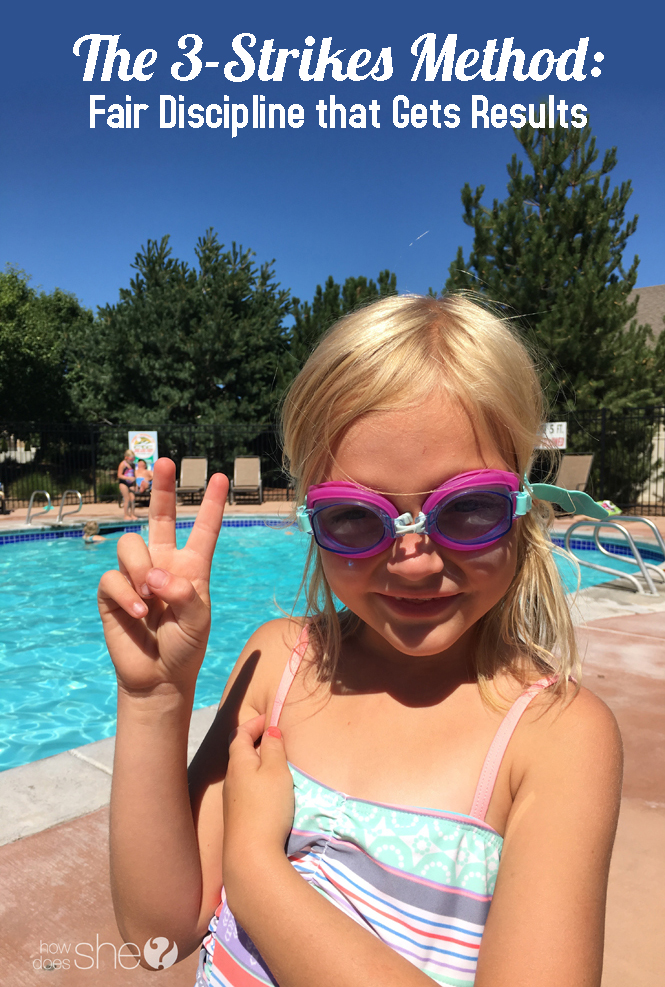Disciplining children is one of my least favorite parenting jobs. In my ideal family—the one that existed in my head before the real ones appeared—everyone got along. All the time.
In reality, I’ve got four kids who are sometimes best of friends and sometimes worst of enemies. As a mom, I can deal with throw-up. I can tolerate boogers wiped on walls. But I cannot handle all the fighting, teasing, tattling, and prodding…it drives me crazy!
If you’re looking for a fair method of disciplining children that truly gets results, try the 3-strikes method. It has worked wonders in our home, and I’ve been using it for close to a year now. I love it because:
- there are no gimmicks or charts involved.
- It is 100% fair.
- Gives kids AMPLE warning before they get a consequence.
- Teaches kids that there are natural consequences to their decisions.
The 3-Strike Method for Discipling Children
Basically, a strike is a verbal warning for bad behavior. Every day, each child is allowed three strikes, or three verbal warnings before they lose a privilege. Yup, just like in baseball. It’s a metaphor my kids can relate to.
I decide at the beginning of the day what the special privilege is going to be, and it depends on what we happen to be doing that day. The key is, the privilege that they potentially lose has to be something they care about.
They Lose Something They Care About
By the time they get their first strike, I tell them the privilege they will lose if they get to strike 3. It’s usually something we are going to do as a family that day, like go to grandma’s house, go to the pool, or eat ice cream after dinner.
Here’s a little scenario:
My six-year-old is ruthlessly teasing his baby brother.
Me: “Buddy, that’s strike one for you. You can’t tease your baby brother like that.”
N: “Well, what am I going to lose?”
Me: Thinking about what we’re doing that day…”You won’t be able to go swimming with us when we go to the pool after lunch.”
N: “Where will I go then? I can’t stay home alone.”
Me: “No, you can’t. You’ll sit on the side of the pool in your clothes while we all swim.”
Now that’s serious business.
The 3-Strikes Method is 100%Fair
I love this method of disciplining children because it uses open communication between parents and kids. From the time they get their first strike, kids are aware of the consequence they will get if they continue to choose bad behavior. The consequence is never a surprise to them, and it’s never sprung on them. They have more than adequate warning time before they get their consequence. In this way, even the child sees the consequence as fair because they were given control over the matter instead of a rash consequence dealt out in the heat of the moment leaving them feeling blindsided and robbed.
The 3-strikes method also teaches children that there are consequences that occur from their choices. With strike 1, my six-year-old got his first warning. He was made aware that his teasing was not acceptable and informed what the consequence would be if he kept it up. Let’s see how the rest of his day went:
N: Knocks down his sister’s block tower.
Me: “Hey buddy, I need you to be nice to your sister. Build your own tower. If you knock down her tower again, you’ll get your second strike for going to the pool.”
Eight minutes later I hear crashing blocks and a wailing sister. Upon further investigation, my suspicions are confirmed. He just couldn’t help it; he knocked down the tower.
Me: “Shoot, I’m sorry you made a bad choice. I warned you about knocking down her tower. This is strike 2 for you. If you get one more strike, you WILL NOT be going swimming with us later.”
They Can Earn Strikes 1 and 2 Back
Because I believe in a repentant soul, I allow my kids to earn strikes one and two back through exceptional behavior. To earn a strike back, they need to do something beyond the norm, like make a sibling’s bed for them or give up their favorite toy to their baby brother, etc. It needs to be a conscientious good choice that they make in their own free will.
They can’t earn strike 3 back though. By that time, it’s just too late, like a convict trying to get out of the electric chair.
This teaches them that there are payoffs for their positive behavior. It also gives them a chance at a clean slate, which I think is important, and it’s another reason this method is so fair.
How do you keep track?
Like I said, I love this method because it doesn’t require any cutesy papers or charts. I can mentally keep track of each kid’s strikes, and you’d be amazed at how well THEY keep track of them for themselves and for each other. I’ve never had to write them down, but you can if you’d like.
You HAVE To Follow Through with Your Consequence
The crux of this entire system and the only way it will work is if you keep your word. If you say that little Jane won’t be able to go to grandma’s house if she earns three strikes then she can’t go to grandma’s house when she earns three strikes.
Even if she shows you those big doe-eyes, even if she cries real tears, even if she begs and swears she’ll do better next time. Just remind yourself, you gave her AMPLE warning and she continued to conscientiously make bad choices, even after strike 1, even after strike 2, and she just didn’t feel like earning those strikes back.
One of the hardest parts of being a parent is seeing your kid lose an important privilege, but you’ve got to stick to your guns on this one. Believe me, it makes a HUGE impression.
Strike 3 Gets Results in Discipling Children
Well, as you can guess, my six-year-old was on a path of self-destruction that day and things went from bad to worse. He didn’t want to listen, didn’t want to stop teasing, and didn’t want to earn any strikes back. By lunchtime, he had earned strike 3.
I think he thought I wouldn’t actually follow through. In fact, he went upstairs with the other kids to get his swimsuit on.
Me: “Nah ah ah buddy. You don’t need a swimsuit, you chose not to swim remember?”
N: Panic starting to creep up in his eyes. “NOOOOOOOO!!!!!” Like I didn’t mean business. “I promise I won’t tease anymore! I want to swim, I WANT TO SWIM!!!”
This is where it gets tough, but if you want lasting results, and if you want the 3-strikes method to work, you cannot relent.
That afternoon, there was a sad little boy sitting on the side of the pool, fully clothed. But he learned a valuable lesson that day. He learned that his actions have consequences and that mom and dad mean business. Isn’t that exactly what we hope to accomplish when disciplining children?
Lessons Are Learned with the 3-Strike Method of Disciplining Children
It’s not always fun being a parent, and it’s definitely not fun being the bad guy. But with the 3-strikes method, you don’t have to be! It’s fair, gives kids the power to choose for themselves, and gives them more than enough warning and even allows for them to correct their behavior. And if you use it correctly, the day will come when your kids never get to strike three. That type of day is a home run in my book.
We know parenting isn’t easy, but there are lots of real life solutions that we have found REALLY work! Here are a few more of our favorite ways to handle the dirty work of discipline in the home:
Let’s Make a Deal: 7 Parenting Tips to Negotiating with Your Kids
Four Battles You Should Let Your Kids Win
Characteristics of First, Middle, and Last Children and How To Best Love Them
The post The 3-Strikes Method: Fair Discipline that Gets Results appeared first on How Does She.
by Nicolette via Home And Garden







No comments:
Post a Comment